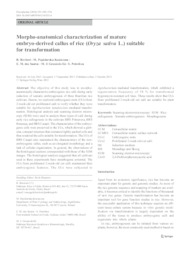Morpho-anatomical characterization of mature embryo-derived callus of rice (Oryza sativa L.) suitable for transformation.
Morpho-anatomical characterization of mature embryo-derived callus of rice (Oryza sativa L.) suitable for transformation.
Author(s): BEVITORI, R.; POPIELARSKA-KONIECZNA, M.; SANTOS, E. M. dos; GROSSI-DE-SÁ, M. F.; PETROFEZA, S.
Summary: The objective of this study was to morphoanatomically characterize embryogenic rice calli during early induction of somatic embryogenesis of three Brazilian rice cultivars. Herein, we explored embryogenic units (EUs) from 2-week-old cut proliferated calli to verify whether they were suitable for Agrobacterium tumefasciens-mediated transformation. Histological analysis and scanning electron microscopy (SEM) were used to analyze these types of calli during early rice callogenesis in the cultivars BRS Primavera, BRS Bonança, and BRS Caiapó. The characteristics of the embryogenic cells were preserved in the EUs, which showed a globular, compact structure that contained tightly packed cells and thus rendered the cells suitable for transformation. The EUs of BRS Caiapó also maintained the characteristics of the nonembryogenic callus, such as an elongated morphology and a lack of cellular organization. In general, the observations of the histological sections corresponded with those of the SEM images. The histological analysis suggested that all cultivars used in these experiments have morphogenic potential. The EUs from proliferated 2-week-old cut calli maintained their embryogenic features. The EUs were subjected to Agrobacterium-mediated transformation, which exhibited a regeneration frequency of 58 % for transformed hygromycin-resistant cell lines. These results show that EUs from proliferated 2-week-old cut calli are suitable for plant transformation.
Publication year: 2014
Types of publication: Journal article
Keywords: Arroz, Embriogenese, Morfogenese, Oryza sativa
Observation
Some of Embrapa's publications are published as ePub files. To read them, use or download one of the following free software options to your computer or mobile device. Android: Google Play Books; IOS: iBooks; Windows and Linux: Calibre.
Access other publications
Access the Agricultural Research Database (BDPA) to consult Embrapa's full library collection and records.
Visit Embrapa Bookstore to purchase books and other publications sold by Embrapa.

